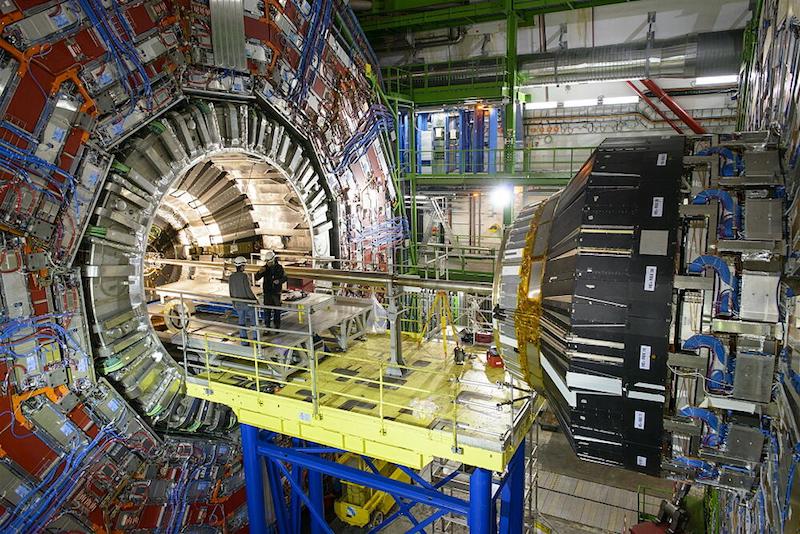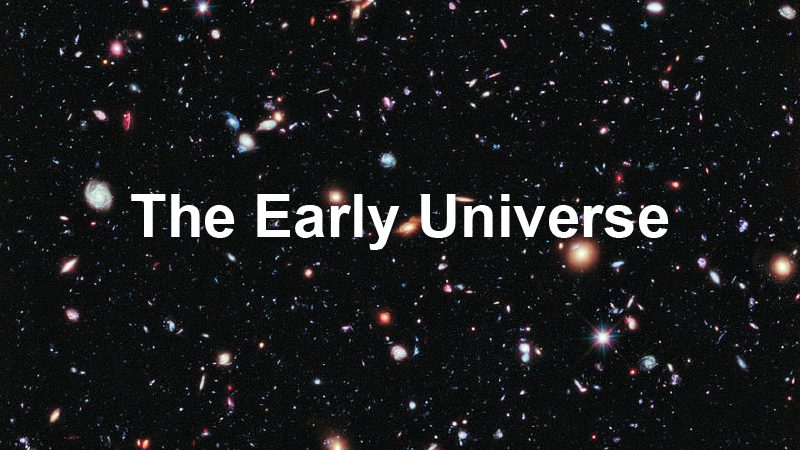The Early Universe
Episode #2 of the course A short history of the universe
When the universe was 10-36 seconds old, it became cool enough for the symmetry of the unified force to break; the three known fundamental forces of nature other than gravity (the strong, electromagnetic, and weak forces) had been unified in one force, but now the strong force became distinguishable from the other two, which remained together as the electroweak force. This Electroweak Epoch of the universe began, either at the beginning or end of cosmic inflation (according to different theories), when the universe was 10-32 seconds old. This means that the universe was no longer energetic enough to create the particles that carry the Grand Unified Force, according to the theory of super-symmetry. Soon, physicists should be able to confirm or reject this theory using particle accelerators, such as Switzerland’s Large Hadron Collider (LHC), to create microscopic explosions with energies as high as the universe at that time, creating the particles that carry the Grand Unified Force. The LHC has begun these tests so recently and results are emerging while I revise this (June 19, 2016); two days ago they announced that an unpredicted particle has appeared during the experiments, strongly suggesting that our current model of particle physics is wrong!

Large Hadron Collider
But according to the only model we have at this time, the universe from 10-36 until 10-12 seconds saw a series of spontaneous symmetry-breaking events, where the forces of nature, which had been unified (symmetrical) at higher energies, spontaneously lost their symmetry as the universe expanded and cooled. Symmetry-breaking can be compared to water vapor condensing or ice freezing; as things get cooler, they naturally become less homogenous and symmetrical.
During the Electroweak Epoch, the universe was a dense, hot plasma of quarks (the constituents of nuclear particles), gluons (the carriers of the strong force), W and Z bosons (the carriers of the electroweak force), other leptons (such as electrons and neutrinos), and the infamous Higgs bosons, mistakenly called “the God particle” in popular media. The Higgs particles simply give mass to the other particles by interacting with them and slowing them down. The LHC at CERN in Geneva is now reaching energies high enough and has created Higgs bosons. The W and Z bosons were detected there in 1983, confirming the electroweak force.
It may be during the Electroweak Epoch that the matter/anti-matter imbalance of the universe was created. There are anti-matter versions of all particles of matter, and the fact that the universe appears to be made almost entirely of matter, is a mystery. According to theory, it was when the Higgs field began decaying and giving mass to particles during the Electroweak Epoch that it created this imbalance by decaying into slightly more quarks than anti-quarks, as one of many random ways which the Higgs field could have decayed (just like a ball on top of a pointy hill can randomly roll down in any direction). A little later, most of those anti-quarks would annihilate themselves by colliding with most of the quarks, leaving the left-over quarks to form all of the protons and neutrons that exist today.
By 10-12 seconds after zero, the universe cooled enough for the electromagnetic and weak forces to separate. For the first time, the universe was ruled by the four forces we know today. It was still too hot for the quarks to become bound and hidden inside protons and neutrons, so this is known as the Quark Epoch.
At around 10-6 (one billionth) of a second after the beginning, the universe had cooled enough for the quarks to stay bound together into hadrons (heavy particles) including most importantly, the baryons—the protons and neutrons that make up the nuclei of all atoms. It was during this process (baryogenesis) that most of the anti-hadrons and hadrons destroyed each other, leaving just the left-overs to make up all the atoms in the universe today.
Since there were no more free quarks at this point, the universe was dominated by the other leptons—mainly electrons and neutrinos—so this time from one billionth of a second until the end of the first second is known as The Lepton Epoch. During this time, the plasma filling the universe became thin enough for neutrinos to “decouple,” meaning that they could now travel freely through space for significant distances without hitting anything. Therefore, the neutrino radiation coming from this time still fills the universe, and we may be able to detect it someday and learn a lot from it.
Recommended book
“The Theory Of Everything” by Hawking W Stephen
Share with friends

